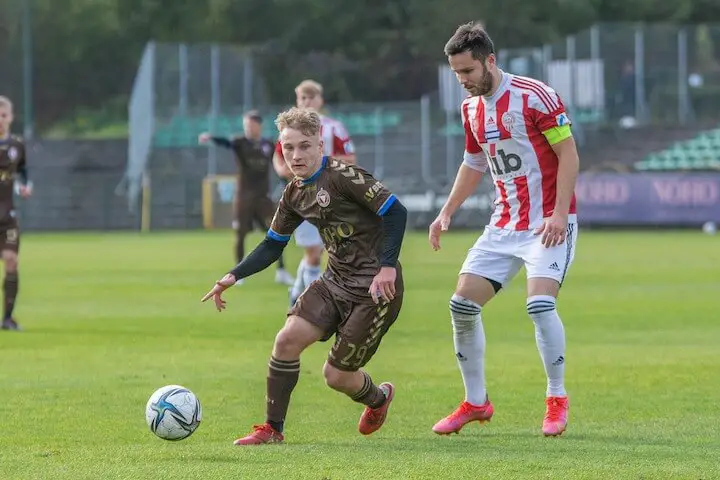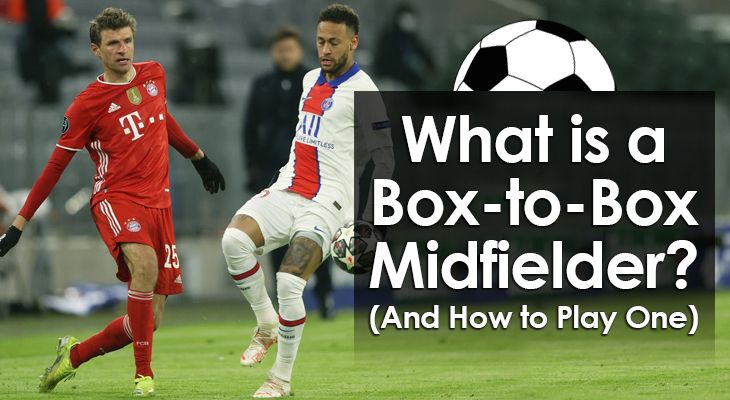What is a Box-to-Box Midfielder? (And How to Play One)
A simple description of a box-to-box midfielder in soccer is a midfield player who can contribute at a high level in both defense and attack.
These players are all-action... they can drive the ball forward when the team is attacking, but also provide defensive cover for the team.
Many teams have at least one box-to-box midfielder among their ranks, and often in their starting XI as they provide a lot of cover and utility play in various areas of the field.
There are a couple of other reasons why a box-to-box midfielder is an important role, and this article discusses some of them.
Key Attributes of a Box-To-Box Midfielder
The three most important attributes required to be an excellent player in this role are:
1. Stamina
It may seem like an oversimplification, but stamina is the most important thing for a box-to-box midfielder.
This is because a player without excellent stamina will simply be unable to cover as much ground as required in the role - at least not for an extended period of time.
Without that stamina, other skills and functions required in the role will suffer.
You may find that the player starts to lose concentration more easily, or make wayward passes more frequently.
They may be slower in making recovery runs to defend or lack the fitness to make the lung-bursting runs that will sometimes be required to provide support when the team is trying to overload the opponent in the attack.
An excellent box-to-box midfielder should have the stamina to last them a game without losing breath to perform their defensive and attacking duties.
A good example of a box-to-box midfielder with excellent stamina is N’golo Kante of Chelsea Football Club.
2. Ball Control
Off the ball, all the work done by a box-to-box midfielder will be tactical or physical.
However, when they are on the ball, more finesse and control are needed.
It's much harder to remain in control of the ball when you’re bursting through the midfield than it is when there’s no pressure or urgency.
Considering this fact, an excellent player in this role should have very good control of the ball.
An example of a box-to-box midfielder with excellent ball control is former Barcelona and Manchester City player, Yaya Toure.
He has the perfect stature for the role, and those physical attributes combined well with his technique to make him very efficient in both areas of the pitch.
3. Strength
This attribute is key for a player in this role in both defense and attack.
While defending, a box-to-box midfielder will rely on strength often to win duels and bully players off the ball to win possession.
While attacking, that strength will again be useful to maintain balance while under pressure from the opposition.
Leon Goretzka of Bayern Munich is an example of a box-to-box midfielder with great strength.
In fact, he famously put in a lot of work in the gym after joining the club to be more effective in the role required of him.

Do They Contribute More to Defense or Attack?
Box-to-box midfielders tend to vary in terms of how competent they are in defense or attack.
Some box-to-box midfielders are good enough at both ends of the pitch, but better with defensive duties than attacking duties, while for others, the reverse is the case.
For instance, N’golo Kante of Chelsea Football Club is better known for his defensive ability than his contribution on the attack.
On the other hand, Steven Gerrard of Liverpool Football Club is better known for his contribution in attack.
Both of these players have functioned frequently as box-to-box midfielders for their respective teams.
Which Teams Need A Box-to-Box Midfielder?
Box-to-box midfielders are often used by teams that favor counter-attacking or defensive tactics because these setups usually require the most running.
Teams that play possession-oriented soccer typically favor a system that involves as many players as possible in each attacking move, so there will be less need for an individual player to do a lot of running with or without the ball while the team is in possession.
Box-to-box midfielders were a dime a dozen when the flat 4-4-2 formation was very popular in the game.
In this formation, having two all-action midfielders in the center of the field helped each one to balance the other out, such that when one was attacking, the other was on standby to defend and vice-versa.
However, the 4-2-3-1 has become more popular in modern soccer, which means that teams more often use only one box-to-box midfielder between the two.
The same applies to the 4-3-3 formation with one defensive midfielder at the base of the midfield.
Less popular formations such as the 4-4-2 diamond and the 3-4-3 formations can still function effectively with two box-to-box midfielders.
In fact, we’ve seen Chelsea Football Club use the latter tactic to good effect with N’golo Kante and Mateo Kovacic in the middle.

10 Excellent Box-To-Box Midfielders
Despite consistent expectations on how a box-to-box midfielder should contribute, each person has their own individual approach to it.
Some players are more physical, some are more technical, while some are more tactical.
Retired players that you can learn the role of box-to-box midfield play include:
- Edgar Davids
- Steven Gerrard
- Yaya Toure
- Michael Ballack
- Bastian Schweinsteiger
The following players are still active (as of writing), and you can also learn from how they play the role excellently:
- Arturo Vidal
- N’golo Kante
- Paul Pogba
- Sergej Milinkovic-Savic
- Mateo Kovacic
Conclusion
The box-to-box midfielder role might not be as popular as it used to be, but it's still very much part of the game.
Interestingly, a box-to-box midfielder can adjust to functioning in other roles due to their wide range of skills, but the same cannot easily be said of fitting other types of players into the box-to-box role.
If you’re starting off soccer training to be a midfield player, perhaps training to be a box-to-box midfielder is a good way to go!
Further Reading: 11 Soccer Positions Explained (Roles and Responsibilities)

